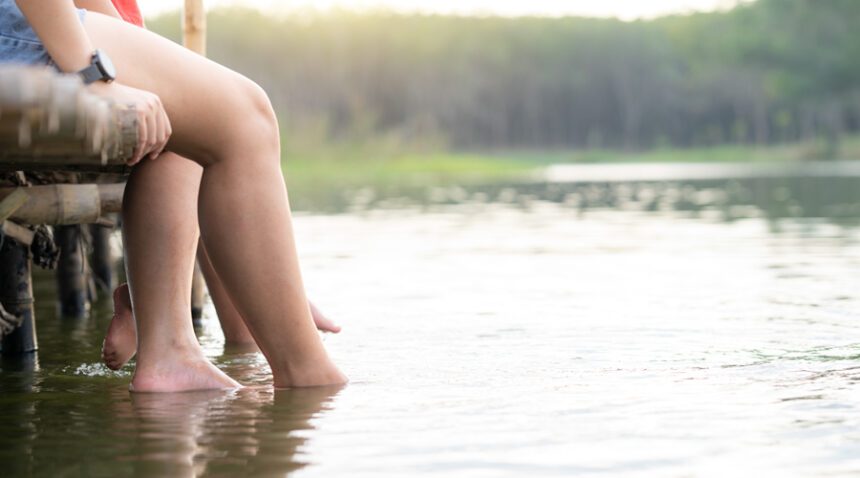
Aven Moffat was 6 years old in 2021 when he went swimming in a private pond with his outdoor-loving family. Soon after, Aven complained of a mild headache. By the next morning, the headache was severe, his fever was high, and he was vomiting. His parents took him to an urgent care clinic where they ruled out strep throat and COVID-19.
When Aven didn’t improve, the family took him to UNC Children’s. A lumbar puncture (spinal tap) ruled out common causes of meningitis, which is inflammation around the brain, but the cause of his inflammation remained unknown. Still, his heart rate and blood pressure levels fluctuated dangerously. He was aware in one moment and asleep the next. At one point, he was unable to recognize his parents.
The next day, after closer inspection of the cerebrospinal fluid, doctors told Aven’s family that they suspected he had been infected by Naegleria fowleri, also known as brain-eating amoeba.
Less than a week after being admitted to the hospital, Aven died from a condition called primary amebic meningoencephalitis (PAM) caused by a tiny amoeba that entered his head through his nose as he swam in the freshwater pond.
Aven’s family wants to raise awareness of the dangers of Naegleria fowleri.
“We can’t bring Aven back,” says his mother, Debra, “but if we can save one other person, we’re doing our best.”
Rare But Deadly
Naegleria fowleri cases are rare, according to the Centers for Disease Control and Prevention (CDC). Only 29 infections were reported to the CDC from 2013 to 2022. Two more were reported in July 2023—one in Georgia and one in Nevada. The death rate, however, is more than 97 percent. In the United States between 1962 and 2022, only four people have survived Naegleria fowleri out of 157 people known to have been infected. One person from Mexico is known to have survived.
“Naegleria infections are extremely hard to diagnose,” says UNC Health pediatric critical care physician Benny Joyner, MD, MPH. The symptoms are similar to meningitis or other infections of the brain.
Early symptoms include headache, fever, nausea and vomiting. As the infection progresses, the symptoms include a stiff neck, seizures, altered mental status, hallucinations and coma. The amoeba destroys brain tissue, causing brain swelling and death.
Symptoms can start between one day and 12 days after exposure, with the average being about five days. Death occurs between one day and 18 days after exposure. The disease progresses so quickly that sometimes it is not diagnosed until after a person’s death.
The CDC reports that most infections occur in males younger than 14. “We don’t know why this group is most at risk,” Dr. Joyner says. “It could be that they are very active and playful in the water.”
Found in Freshwater During Warm Weather
Naegleria are microscopically small, single-celled organisms commonly found in freshwater, such as lakes, rivers, ponds and hot springs. They can also be found in swimming pools, splash pads, surf parks and other recreational venues that don’t contain enough chlorine. They are found in soil, too. They are not found in saltwater, such as ocean water.
The amoebas are more likely to live in sediment at the bottom of lakes, ponds and rivers, and when the sediment is stirred up, it could disperse them in the water, Dr. Joyner says.
“This can more easily occur in shallower lakes,” he says, “which is problematic because shallower lakes can be warmer and, as such, could be where more Naegleria are found.”
Typically, Naegleria are in water warmer than 80 degrees F. Cases have been reported in states across the southern United States, with Florida (37 cases) and Texas (39 cases) reporting the most. There is evidence that Naegleria fowleri’s range is expanding northward, with one incidence as far north as Minnesota.
Enters the Body Through the Nose
Naegleria fowleri gets into a person’s brain when water containing the amoeba goes up the nose, probably after swimming or diving in freshwater with head submerged.
Irrigating sinuses using a nasal wash (such as a neti pot) can be risky if the water has not been purified or distilled. There is an extremely small risk that Naegleria can be found in tap water.
You cannot get infected from drinking water that contains Naegleria, and you cannot get it from another person. There’s no evidence that infections can occur through water vapor or droplets, such as from a shower or vaporizer, Dr. Joyner says.
Easier to Prevent Than Treat
The best way to prevent Naegleria infection is to avoid any activities that will cause potentially contaminated water to go up your nose, Dr. Joyner says.
“Be aware of the danger, especially during warm months,” he says. “If you are going to cool off in a freshwater lake or pond, don’t jump or dive or put your head underwater. If you are going to swim, then use nose plugs.”
Once the amoeba has entered your nose, you can’t get rid of it by rinsing your sinuses or blowing your nose.
Moffat says neither she nor anyone in her family will ever go in freshwater again. But she knows it’s a popular summer activity. Besides keeping your head above water or wearing nose plugs, she recommends checking the chlorine level at pools and water parks with chlorine test strips that are easily available.
“If the chlorine levels are not what they need to be,” she says, “don’t get in.”
Not Well Known, But That’s Changing
After Aven’s death, Moffat’s family and friends looked for ways to educate people about the risks of Naegleria infection. Before Aven was diagnosed, none of them had ever heard of Naegleria fowleri or PAM.
“We got the one-in-a-billion chance of getting this awful amoeba,” she says.
The family has set up a website, Amazing Aven’s Quest for Amoeba Awareness, to provide information about Naegleria, raise awareness and support research. Moffat has reached out to nearly 100 families who have been affected by Naegleria.
“Doing what we can to potentially save others’ lives and keep another family from going through this gives us a reason to keep going,” she says.
Early diagnosis may prove to be the key to saving lives.
“The next case will happen,” she says. “We want it to be on people’s radar. We want doctors to know what questions to ask.”
If you’ve been swimming in freshwater and develop a headache, fever, nausea and vomiting that doesn’t get better, see a doctor right away. Need a doctor? Find one near you.

